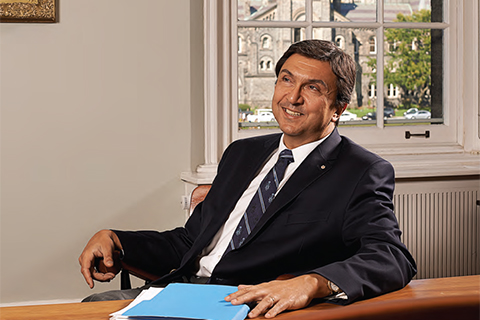Each spring, the Governing Council votes on a proposed tuition schedule for students across the University of Toronto’s many faculties and programs. The university needs tuition revenue to provide our students with high-quality programs that compete with the best internationally. At the same time, we must maintain access for the best and brightest students regardless of their economic background. To sustain this delicate balance, the university relies heavily on alumni, both as donors and taxpayers, for financial support. A few words about university finance may therefore be timely.
In 2005-6, U of T’s budget was about $1.2 billion. Our core provincial grant now represents about 44 per cent of that total, down from 70 per cent in 1991-92. Tuition has risen from 16 to 34 per cent of revenue. The remaining 22 per cent comes from other sources, such as endowment payouts, federal government support and divisionally generated income.
Why has our dependence on tuition fees grown? The main reason is the failure of provincial funding per student to keep pace with the costs of a university education. Ontario has been dead last among the provinces in per-student funding of higher education for about 15 years. From the early 1990s to 2004-05, per-student inflation-adjusted funding from the provincial government (not including direct grants and research awards) fell by about 30 per cent. Meanwhile, public spending on health care has kept pace almost exactly with overall growth in provincial GDP.
On the expense side of the ledger, salaries for our faculty are about 20 per cent higher than the national average. That’s essential if we are to recruit and retain outstanding academics who are in demand nationally and internationally. Unfortunately, our provincial operating grant is not adjusted for the high cost of living in the Toronto region or the calibre of our faculty and staff. Additional cost pressure results from our inventory of heritage buildings, while unexpected utility costs alone bit an extra $12.5 million out of our budget last year.
Although grants underwrite the direct costs of research done on campus, the university must also pay for indirect costs such as laboratory upkeep, ethics reviews, research holdings in libraries and the administration of research grants themselves. Province of Ontario research grants do cover most of these indirect costs, but federal granting councils cover indirect costs far below the levels paid nationally in the U.K. and the U.S. Most other agencies provide no support at all for indirect research costs.
As to education costs, the provincial government recently responded to the deplorable level of per-student funding in Ontario with its very welcome Reaching Higher Plan. The plan promised $6.2 billion in expenditures over five years. But much of the funding is directed to student aid, to the college sector and to enrolment growth. According to the Council on Ontario Universities, even by 2009-10, the additional resources committed per student are unlikely to move Ontario out of last place among provinces.
I am sometimes asked why Ontario has fallen so far behind in funding universities. The answer lies partly in the provincial recession of the early 1990s and tax cuts made by the province thereafter. As noted, health care was largely spared, and the reduction in public spending had to come from somewhere. Today, however, Ontario’s taxes are about average for Canadian provinces, and the Ontario government is still struggling to finance social spending. How is it that Newfoundland can afford to spend 40 per cent more per capita on universities and colleges than Ontario? The answer lies in the movement of money between the federal and provincial governments. Whatever position one takes in the debate about fiscal federalism, it seems self-evident that all Canadians eventually lose when there’s a constant family feud over finances, and when 40 per cent of Canada’s post-secondary students – those at universities and colleges in Ontario – wind up shortchanged.
On that last point, anyone who has travelled to the Far East recently, as I have, will be struck by how countries there are making an enormous investment in their universities. The world is changing. To succeed as a nation we will need to be more than hewers of softwood and drawers of oil. We must be active participants in the global knowledge economy. And that’s why continuing investment in knowledge creation and knowledge transfer at our universities – among them, your alma mater – is so essential.
Sincerely,
DAVID NAYLOR
Recent Posts
For Greener Buildings, We Need to Rethink How We Construct Them
To meet its pledge to be carbon neutral by 2050, Canada needs to cut emissions from the construction industry. Architecture prof Kelly Doran has ideas
U of T’s 197th Birthday Quiz
Test your knowledge of all things U of T in honour of the university’s 197th anniversary on March 15!
Are Cold Plunges Good for You?
Research suggests they are, in three ways





